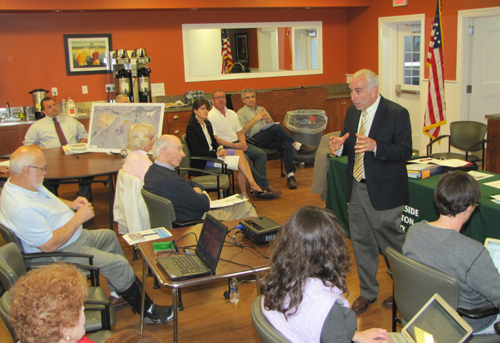Riverside residents urged to make the call on pursuing sewers

Whether a new sewer district is built to serve commercial development in Riverside will be up to the people who live there, officials stressed during a civic meeting on the subject Monday.
“We want to make sure all of you have a say in this,” Southampton Supervisor Anna Throne-Holst told members of the Flanders, Riverside and Northampton Community Association. “It’s not going to happen unless that’s what you all want.”
The county Department of Public Works recently began a $250,000 study of the pros and cons of establishing a Riverside sewer district, but it is still too early in the process to identify things like the cost of building a district or the impact it would have on taxes.
Either way, it won’t happen overnight.
“Even if everything falls into place, it takes five to seven years” to build a sewer district’s infrastructure, said DPW commissioner Gil Anderson, also at the meeting.
“Our community is economically depressed,” said FRNCA president Brad Bender. “We lack jobs, we have lots of blight and closed up buildings and things that are dilapidated and falling down. And the reason we can’t redevelop this is because our commercial base has no ability to sewer itself.”
The first step in creating a sewer district would be to establish a district boundary. Officials anticipate that initially the sewers would only serve commercial development, not residential areas.
A public referendum would also be needed to establish the district, Mr. Anderson said.
“Through the years, people have been saying to me, ‘What can we do to revitalize this area?” said county Legislator Jay Schneiderman (I-Montauk), who spoke at the meeting.
Because of Riverside’s high water table and proximity to the Peconic River and Pine Barrens, it’s difficult to build any type of significant commercial development without access to a sewer system, he said. For example, the hotel proposed for 20 acres along the Peconic River in Riverside ran into environmental roadblocks, and the bulk of the site was acquired for preservation. Only about three acres can now be developed.
And the lack of commercial development is one factor cited as contributing to the area’s low tax base, which forces a greater property tax burden onto residential property owners.
The current proposal would create a sewer district that extends from the former drive-in site to the traffic circle along Flanders Road in Riverside.
An earlier proposal, later rejected, extended the district as far east as Longneck Boulevard and Flanders Road.
The consultants doing the study, Camp Dresser McKee-Smith and H2M, have identified three possible locations for a new sewer plant — the county center, the former car dealership site on Riverleigh Avenue and a vacant site adjacent to MacLeod’s Mobile Home Park on Riverleigh Avenue.
MacLeod’s resident Jill Ponchitera asked if there would be any odors coming from the plant.
Frank Russo of H2M said there are occasional “burps” but the plant design has built-in odor controls to address these situations.
“Does it occasionally burp? Yes, it occasionally burps,” he said.
How often?
“If it happens once a year, that’s a lot,” Mr. Russo said.
As for the location, H2M said the closer the plant is to the district, the less expensive it will be. The plant would be required to be at least 200 feet from homes, according to H2M. It would likely be operated by the county Department of Public Works.
“I can attest that my staff really works hard to be good neighbors,” DPW commissioner Anderson said of the odor concern. Mr. Anderson also said that while there would be trucks going in and out of such a facility, “I wouldn’t categorize it as noisy.”
The treatment plant would discharge treated effluent into the ground, rather than into surface waters like the bay, said Nick Bono of H2M. He estimates a Riverside-Flanders district would need a plant that can handle about 300,000 gallons per day.
By comparison, Riverhead Town’s sewage treatment plant is designed to handle 1.4 million gallons per day, Mr. Russo said.
Only property owners within the proposed district would pay for the sewer, Mr. Schneiderman said. Most residential property owners would pay no additional tax for the sewer district, he said.
Mr. Schneiderman said residents also have to consider the impact of not establishing a sewer district.
“We could all just go away, but then you are going to be stuck with the boarded up buildings,” he said.
Ms. Throne-Holst urged people to call her office with feedback on the proposed sewer district, and said that a website will be created giving updates on the project. There will be a link to the site from the town’s web site.








